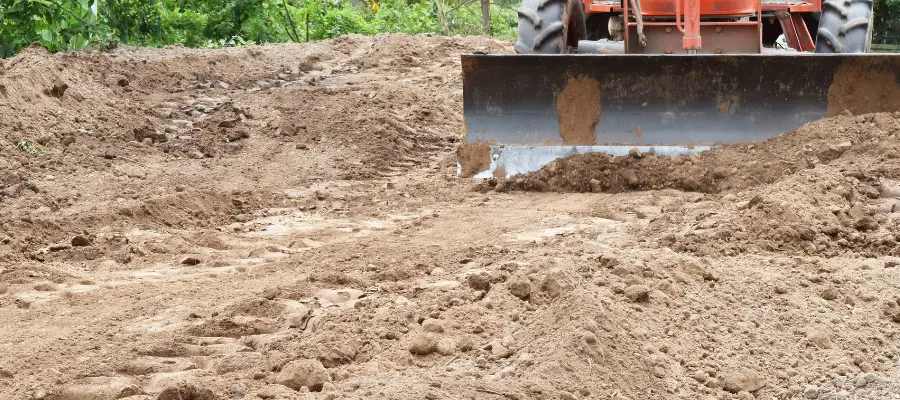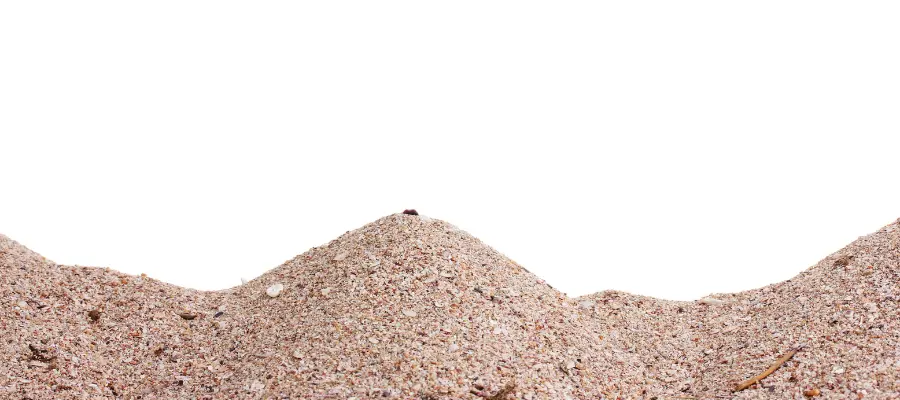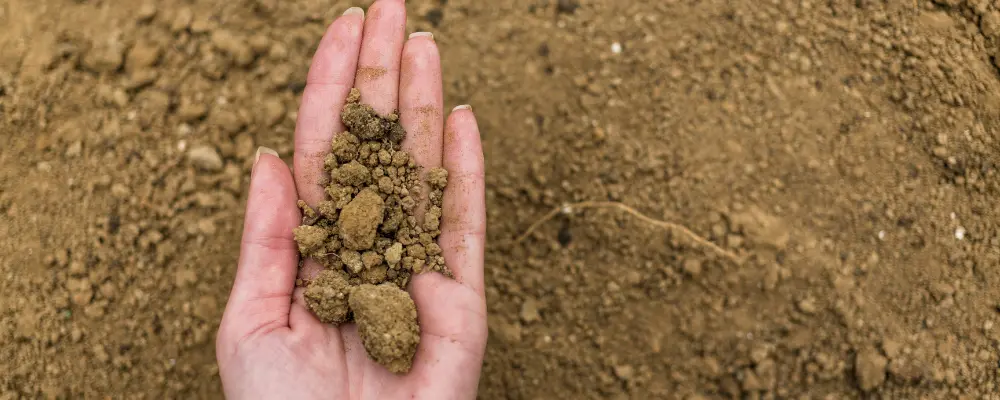A detailed knowledge of the various soil types and properties is vital before starting the work on foundations & construction. Because different types of soil will affect your building’s foundation based on its physical and chemical properties. Choosing the right type of foundation is very crucial according to the soil type.
Hence, in this blog of Brick & Bolt, you will explore the different types of soil for building foundations and construction to understand which type of foundation is best suitable for your dream construction project.
Understanding Soil Composition
The soil is a combination of minerals, organic matter, water, and air, varying in composition. It generally contains sand, silt, and clay. It’s constituents determine its properties and suitability for different purposes.
Soils are often more stable when they include a higher proportion of rock and compacted sand or gravel. During the home foundation process, the soil must be capable of staying stable during wetting and drying cycles so that foundations do not crack because of normal expansion and contraction.
Good soil for construction is that which is capable of capturing precipitation, preventing runoff and erosion from causing structural damage. A good infrastructure soil should be chemically balanced to prevent material deterioration. It should also contain minimal organic material, which can decay over time and cause movement beneath the foundations.
Common Types of Soil for Building Foundation

The following are the major types of soil for building construction:
1. Clay Soil
Clay is made of fine mineral materials and little organic material. It’s generally found where streams and rivers once flowed or in an area where water tends to sit after heavy rainfall. It becomes sticky when wet and does not drain effectively. Its small particles cause it to expand and push on the foundation’s wall when moist. And when it dries, it shrinks, causing the foundation to shift. It can cause fissures and unequal levels in a building if not amended. Hence, it is unsuitable for foundation construction due to its instability.
To construct the right type of home foundation, the ground must be dug deeper to ensure stability. A drilled pier or a slab foundation appears best suited to clay soil.
A slab-on-grade foundation controls the soil’s tendency to expand and contract after construction, but a drilled-pier foundation improves structural firmness or stability when dug deeper.
Advantages of clay
It’s the perfect stuff for a tropical climate place.
- Clay soil has excellent thermal insulation properties. This helps to maintain cooler temperatures in structures during hot weather and reduces the need for air conditioning.
- Clay soil retains water well, where dry periods can follow heavy rainfall. This property helps sustain plant life and maintain lush, green landscapes.
- Clay soil is rich in nutrients, making it an excellent choice for gardens and agricultural purposes.
- When compacted, it can support heavy loads, making it suitable for building foundations. Its dense nature educes the risk of shifting or settling over time.
2. Silt Soil
Silt soil is composed of rock and other mineral materials. It also includes tiny particles and can retain water for a long time. Compared to sandy soil, it has considerably smaller particles, making it easily transported by moving water flows. This soil type can be seen near rivers, lakes, and other water bodies.
It is not suitable soil for building a foundation because it stresses the building. These types of soil for building construction does not dry quickly or readily when it contains water. It drains poorly and grows, pressing against the foundation. This results in relatively poor support for construction. The RCC spread, and isolated pad footings are suitable for this silt soil. The foundation’s depth should be more than the erosion, swelling, and shrinkage zones.
Advantages of silt
Silt has fertile ground, can hold more water, and is easier to work with than other soils.
- Silt provides a moderate load-bearing capacity, making it suitable for supporting various types of structures, such as small buildings and road bases.
- When compacted, silt exhibits low compressibility and reduced risk of sinking. This is essential for maintaining structures over time, particularly in areas prone to heavy rainfall.
- Silt acts as an insulator, helping to regulate temperatures and reduce energy costs, where maintaining a stable indoor temperature is crucial.
- It has the ability to retain moisture, which can be advantageous for landscaping and agriculture.
3. Loamy Soil
Loam soil is the most suitable for building foundations. Generally, farming areas contain this type of soil. It contains the right combination of sand, silt, and clay constituents. It can retain moisture and nutrients. It also has a higher pH and calcium level when compared to other types of soil.
Loam soil manages moisture effectively since it absorbs water and dries out consistently. It also allows for air circulation and drains well. However, before starting the construction, the soil should undergo filtration to eliminate any undecomposed particles or elements. This is to prevent further terrible effects.
Loamy soil is suitable for the construction of isolated pad footings. The area and depth are again decided by bearing capacity, groundwater table depth, and load-bearing stratum depth. Isolated pad footings are provided beneath columns and joined/tied together by connecting beams. If the structure has only one story, a continuous strip foundation can be employed; however, isolated RCC pad foundations are preferable if they are cost-effective.
Advantages of loam soil
It’s good for construction because it holds water at a balanced rate. It controls air humidity if applied as a layer to interior walls. It’s best when combined with straw to build walls.
- When applied as a layer to interior walls, loam soil can help regulate indoor air humidity.
- The fertile nature of loam supports healthy plant growth which can enhance the aesthetic appeal of construction projects.
- The combination of sand, silt, and clay in loam soil provides good structural stability. This ensures that buildings and other structures are less likely to settle unevenly, reducing the risk of cracks and other structural issues over time.
5. Peat Soil
The peat soil is generally available in brown or black. It’s commonly seen in bogs and wetlands. Peat contains organic matter that can hold a lot of water, making it easily compressible. Also, the soil can become extremely dry during the hot summer months. Thus, this is also comparatively good soil for construction. If you build on peat soil, the building is very vulnerable to cracks or other types of damage. Isolated and beam foundations will be anchored to a firm soil layer beneath the surface. Without firm subsoil, a raft foundation will be used to extend support for the structure beyond the peat soil.
6. Sandy Soil

Rock soil or sand soil is formed from the decomposition of rocks such as granite, quartz, and limestone. It cannot retain water. This is the best soil for building foundations, as it won’t hold the minimum risk of putting a building under stress.
- Fine Sand: Fine sand has tiny particles. They measure 0.075 to 0.425 millimeters. It feels silky when you rub it between your fingers.
- Medium Sand: Medium sand is different. Its particles range from 0.425 to 2 millimeters. It has a noticeably grainy texture.
- Coarse Sand: The largest particles are in coarse sand. It ranges from 2 to 4.75 millimeters. They make the soil feel rough and chunky. When you try to mold wet or dry sandy soil, the larger particles resist. They cause the soil to crumble and fall apart.
Advantages of sand
- This material excels in construction projects because it effortlessly handles heavy loads. Its drainage capabilities are excellent.
- It is completely free of organic and impure substances.
- Sand, particularly coarse sand, provides a stable foundation that can support substantial loads. Its granular structure helps distribute weight evenly, reducing the risk of structural failure.
- Sand compacts well and has low compressibility. This minimizes the risk of sinking or shifting over time.
- Sand is an insulator by nature, helping to regulate temperature by reducing heat transfer.
Stress in a building can cause structural and non-structural fissures to form, potentially leading to the building’s collapse. Hence, for sandy soil, sand and gravel can be compacted with other high-quality soil types, such as loam soil, to improve stability. Deep foundations like screw piles or helical pliers are good long-term foundation techniques for this soil type. It keeps the sand from washing away while also holding the foundation solid.
7. Gravel Soil
Rocky or gravelly soil is full of small, irregular rocks and stones. Imagine walking by a river or in the mountains. The ground is rough and uneven. This soil is rougher than sand but smoother than stones. The rocks and gravel are tough to dig and plant in. Mountains and eroded areas expose gravel soil.
Water relentlessly breaks down rocks into small pieces. This soil’s nutrient scarcity makes it a challenging environment for plant growth. However, some tough plants have adapted to thrive in these harsh conditions.
Advantages of Gravel Soil
Gravel soil has many benefits in construction and landscaping. It is a top choice for builders, architects, and landscape designers. One of gravel soil’s significant benefits is excellent drainage. Gravel lets water pass through it quickly. This stops waterlogging, which can harm structures or cause erosion.
Some other advantage are:
- It’s high load-bearing capacity. It support substantial loads, making it ideal for constructing roads, driveways, and building foundations.
- It is known for reduced sinking risk especially beneficial for heavy structures and high-traffic areas.
- Gravel helps prevent soil erosion by allowing water to drain through while holding soil particles in place.
- This makes it best choice for landscaping, retaining walls, and embankments.
- It is a cost-effective option for various construction projects as only low maintenance are required to add.
Conclusion
For your home building’s stability and longevity, you must choose good soil for construction. The soil should get soil testing to determine the specific soil properties and to design the foundation based on those characteristics. For the integrity of the structure, you should conduct site preparation, soil compaction and drainage measures. By considering the soil characteristics and selecting the appropriate type of foundation, you can mitigate potential risks to your home building.
If you are also looking for long-lasting and durable home construction, Brick & Bolt is here. As a leading construction company Brick & Bolt provides a wide range of expertise to your project. They can also assist you in selecting the right type of foundation according to your soil type along with the proper construction materials and house floor plans. In addition, you can check your building cost estimation by using our exclusive building cost estimator tool.

